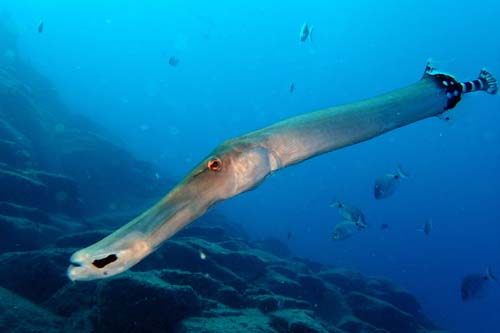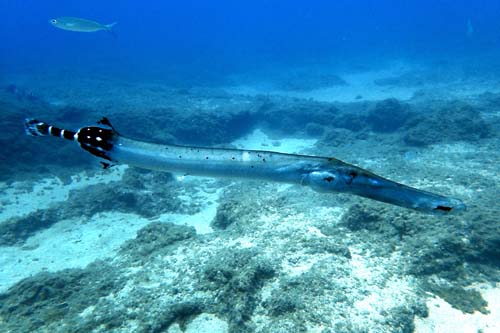Trumpetfish are cool
Why we love to dive with them
We love to dive with trumpetfish in Tenerife! Their distinctive characteristics make them easily recognisable and interesting to watch. Luckily they are very common across our dive sites, so you are likely to encounter at least one during your dive.
As part of the Aulostomidae family they are also in the Syngnathiformes class. This class describes an order of ray-finned fishes that include pipefish and seahorses. Atlantic trumpetfish have an elongated body that ends in a long tubular snout. Their bodies are inflexible, supported by interwoven struts of bone and can reach up to one metre in length.
Generally, trumpetfish will swim with schools of other species of fish. Reasons for this could be for protection or to exploit feeding opportunities. We usually see them amongst a school of bream or roncadores. When hunting, trumpetfish will hang vertically with their head pointed downwards. They use this technique to search for small fish or crustaceans. To capture their prey they quickly expand their mouth. This creates a strong sucking effect which draws the prey into their mouths.
Trumpetfish have the ability to change colour. They use special pigments which help them to mimic features of their environment. This technique is either a way of communication or to camouflage from prey as they are quite weak swimmers. They are usually grey or brown but can also display a pattern of lines, like a zebra’s stripes. Male trumpetfish use their colour changing abilities to attract females. To mate, the female will transfer her eggs to the male to fertilize. The male will then care for the fertilized eggs until they hatch, similar to seahorses.



We really love our trumpetfish in Tenerife!
The next time you dive, make sure you look out for their different behaviors. Additionally, to learn more about marine life in Tenerife, why not take the PADI AWARE Fish ID specialty? During the course you will learn how to recognise fish characteristics and how you can support Project AWARE.
